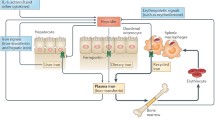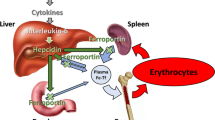Abstract
Human serum, transferrin, and apotransferrin are known to profoundly inhibit the growth of Candida albicans by iron deprivation. On the other hand, iron overload (iron saturated transferrin) is a serious risk factor for candidiasis in newborn and in leukemic patients. We tested the efficacy of fluconazole and the previously demonstrated synergy of fluconazole and effector cells against C. albicans under iron overload conditions where efficacy might be diminished. We confirm that exogenous iron completely reversed the inhibitory effect of human serum and report that the efficacy of fluconazole against C. albicans was not significantly compromised in a 24 h assay system. Although exogenous iron inhibited fungistatic activity of monocyte-derived macrophages, it did not interfere with the synergistic candidacidal activity of fluconazole and monocyte-derived macrophages. In 72 h assays, where fluconazole had candidacidal activity, exogenous iron did not compromise efficacy of fluconazole, and fluconazole activity was often increased. These in vitro results suggest that effectiveness of fluconazole therapy would not be compromised in iron overload situations in vivo.
Similar content being viewed by others
References
Sternberg S. The emerging fungal threat. Science 1994; 266: 1623–1634.
Caroline L, Rosner F, Kozinn PJ. Elevated serum iron, low unbound transferrin and candidiasis in acute leukemia. Blood 1969; 34: 441–451.
Radke LL, Hahn BL, Wagner DK, Sohnle PG. Comparison of metal-bonding anticandidal activities of serum and abscess fluid supernatants. J Med Vet Mycol 1994; 32: 295–301.
Weinberg ED. Iron and infection. Microbiol Rev 1978; 42: 45–66.
Meunier F, Aoun M, Gerard M. Therapy of oral candidiasis in the immunocompromised host: a randomized double blind study of fluconazole vs. ketoconazole. Rev Infect Dis 1990; 12: S364–S368.
Fromtling RA, Galgiani JN, Pfaller MA, Espinel-Ingroff A, Bartizal KF, Nolte FB, Odds FC, Rinaldi MG, Sugar AM, Villareal K. Multicenter evaluation of a broth macrodilution anti-fungal susceptibility test for yeasts. Antimicrob Agents Chemother 1993; 37: 39–45.
Garcha UK, Brummer E, Stevens DA. Synergy of fluconazole with human monocytes or monocyte-derived macrophages for killing Candida species. J Infect Dis 1995; 172: 1620–1623.
Brock JM, Williams PH, Liceaga J, Wooldridge KG. Relative availability of transferrin-bound iron and cell-derived iron to aerobactin-producing and enterochelin-producing strains of Escherichia coli and to other microganisms. Infect Immun 1991; 59: 3185–3190.
Ismail A, Lupan DM. Utilization of siderophores by Candida albicans. Mycopathologia 1986; 96: 109–113.
Moors MA, Stull TL, Blank KJ, Buckley HR, Mosser DM. A role of complement receptor-like molecules in iron acquisition by Candida albicans. J Exp Med 1992; 175: 1643–1651.
Hasenclever HF. The in vitro interactions of Candida albicans, with nonspecific serum proteins. Mycopathologia 1978; 65: 169–176.
Roth FJ, Boyd CC, Sagami S, Blank H. An evaluation of the fungistatic activity of serum. J Invest Derm 1959; 32: 549–556.
Manns JM, Mosser DM, Buckley HR. Production of a hemolytic factor by Candida albicans. Infect Immun 1994; 62: 5154–5156.
Esterly NB, Brammer SR, Crounse RG. The relationship of transferrin and iron to serum inhibition of Candida albicans. J Invest Derm 1967; 49: 437–442.
Author information
Authors and Affiliations
Rights and permissions
About this article
Cite this article
Minn, Y., Brummer, E. & Stevens, D.A. Effect of iron on fluconazole activity against Candida albicans in presence of human serum or monocyte-derived macrophages. Mycopathologia 138, 29–35 (1997). https://doi.org/10.1023/A:1006889108673
Issue Date:
DOI: https://doi.org/10.1023/A:1006889108673




